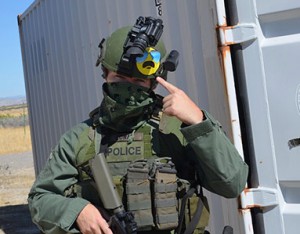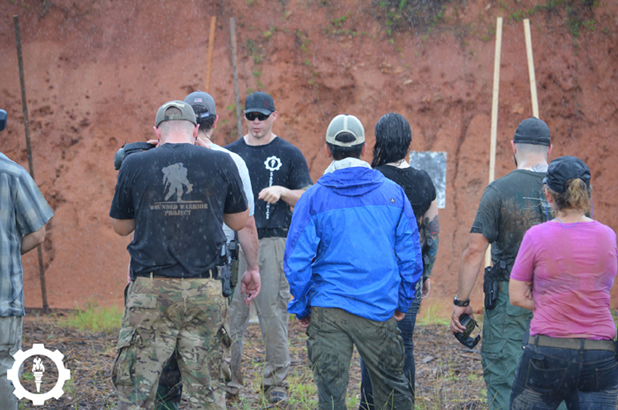We talk about grips a lot. It’s an important topic, whether you’re talking about weapon manipulation or choking the chicken. Today COWAN! is going to review a handstop from Rail Scales, though first you’re going to get the mandatory COWAN! history lesson. Grab a snickers and prepare to learn something. Mad Duo
Review – Serrated Scale Stop (S3)
Breach-Bang-COWAN!
Forward grips in the rifle world have taken a curious route; when the AR/M16 family of rifles was born, the handguard was just that – a somewhat ergonomic guard to protect the hand from barrel heat and aid in balance for accurate fire. As years went by, the handguard went through very few changes and those that did happen didn’t greatly change the method of support hand control of the rifle. From the days when the primary requirement of the rifle was engaging enemies out to 500+ meters the battle space evolved, and the AR was slow to catch up. When the carbine went mainstream and technology advanced beyond iron sights, the shorter handguard on the carbine (and the longer on the full size rifle) was replaced with the venerable Picatinny rail (MIL-STD-1913) to provide the ability to attach accessories. The more accessories, the less room there was for the support hand. This was one of the largest motivating factors behind support hand grips, most notably the vertical grip.
While not such an issue on the rifle, a drop-in Picatinny rail on a carbine leaves very little real estate once lights, optics, lasers and control switches are added. A vertical grip, while not the most ergonomic grip, did provide a solid control surface. The vertical grip craze birthed all manner of options; most were reasonable, some silly, others completely useless. From integrated controls to grips with internal storage, everyone got on board. Training evolved around the grip and changes in common use of the rifle. The need for the average infantryman to engage entrenched soldiers out to 500 meters gave way to the reality of closer engagements and more need for rifle muzzle control. Lessons learned in CQB had support hand training go from providing a stable shooting rest to actually controlling the direction of the rifle muzzle faster than it could be manipulated by the shooting hand. Different techniques were used to work around the sometimes cumbersome vertical grip; the thumbreak grip helped me personally avoid asymmetrical pressure created by use of the vertical grip, but it was at best a work-around caused by the military’s slow (ongoing) change away from the short, thick rail space.
Outside of the military (and in some specialized units within it) the rail space became longer and thinner. Picatinny fell away in favor of modular rails, keymod and then M-LOK. The longer the rail, the more grip options and the less critical hand space became. The AFG from Magpul, as much as it is derided by some, changed the way many looked at muzzle control and ergonomics. It provided a comfortable surface for rifle control and its popularity reflected that, though it (ergonomically speaking) was quite useless on rails that don’t allow full arm extension. It wasn’t long before the hand stop became popular because it allowed a positive indexing point for a default grip and the thinner keymod/modular (and now M LOK) rails allow for a pipe/rope hold on the total rail space (thumb-over-bore too, if you like). All manner of handstops exist, from a wide array of manufacturers: Larue, GripStop, Magpul, Novekse, Ergo, Impact Weapon Components, B5 Systems, etc. Handstop choice becomes a personal preference. I like the most rail space possible; the longer the rail the more grip options I have. But for my default support hand grip, I have long used a handstop of some sort for a positive indexing point and for a surface to balance out rearward seating pressure on the rifle.
The vertical grip has been around nearly as long as firearms. The forward (and rather ergonomic) grip on the Thompson SMG is probably the most recognizable, but patents for grips for the Garand, M14, M1 Carbine and all manner of submachine guns can be found. The hand stop is technically newer, at least in the way we know it but it’s been around for quite some time as well. The Handstop design and intent as we know it today has existed since Mathew Schadeck’s 1957 patent for an “Adjustable Hand Positioner”. Winchester also patented a similar device in 1936, though theirs was to provide a comfortable point for forward (not rearward) pressure and a sling attachment point. From then the idea came and went, though now it is most certainly here to stay.
My first “hand stop” was a cut down Dieter CQD Forward Grip. It was intended to be a full hand vertical; I modified it to two inches in length (similar to the stubby vertical grips from Tango Down and others on the market today). It gave me an indexing point and a rearward hand pressure option without the excess length. My first actual hand stop as we know them now was the Ergo Surestop; it has an aggressive curve that has found its way into a few designs and while it served its purpose, the hook design tends to trap the hand more than I liked. As soon as the Larue handstop hit the market in 2010, I was all over it. Since then, I’ve tried (and used) many other hand stops and own all those on the market I’m aware of. This may not make me a hand stop expert, but I’ve liked the idea for a long time and am in constant search of the best option for my grip and shooting style.
Last year I made contact with the minds at Railscales and ended up doing a review of their Keymod G10 rail panels. They also let me in on a hand stop they have had in development for a while; I bit and was sent out an early demo model made of G10, called the Serrated Scale Stop or S3. The first production G10 model followed a while after and then an aluminum model.
The early production demo, an imperfect version of the production model, is what I spent the most time with; I was warned by Railscales that it might not be as durable or functional as the production models that would follow. I installed the demo model on one of my keymod rails and put it to work. Well after many months I would have to say they lied about it not being durable or functional.
The profile of the S3 is a minimal foot print; it takes up three key mod slots, measures in at around 1 inch vertically and is the same width as many keymod surfaces. The curved surface isn’t acute as some, with a shallow hook that doesn’t trap the hand with use. The front and rear of the handstop are jimped to add grip, which is very beneficial. Most hand stops are not designed with the rear surface use in mind like the S3 is, it can be used in a barricade/cover supported “pool cue” grip in the web of the thumb, or the traditional method. I was fairly certain that the S3, being made of G10, could handle hard use, though maybe not as much as a stop made of aluminum.
Even when digging the stop into a barricade for direct support, it holds up. Repeated use of the S3 in this way didn’t loosen its hardware or cause any damage other than cosmetic scratches. By the time Rail Scales sent me the production version of the G10 S3, I had a few thousand rounds of use with the pre-market model.
The design changes between the pre-market and production G10 stop are very subtle, so much so that the casual observer wouldn’t notice them. Switching to the production version I didn’t notice any differences in the use, overall shape or the durability. The design lends itself very well to multiple uses. Barricade support, as already mentioned, is possible and made fairly easy by the shallow arc of the stop. The purpose built rear arc of the hand stop allows the “pool cue” grip to be used intuitively if you choose and allows the stop to be pushed further forward as a grip limiter for shorter barreled rifles. The short overall height is almost a just right length; long enough for even the biggest mitts yet not so long that the hand stop has a higher risk of snagging on gear, complicating transitions or making quick grip switches difficult.
You might also like to read: Back For the First Time — Grip Stop Done Right.
G10 is a great material for some firearms accessories but to be honest, I don’t trust a hand stop made out of it in the same way I don’t really trust hand stops made out of ABS plastics or polyamides. For a simple indexing point it’s fine, but for barricade support or any very hard use, non-metal stops have always bothered me. It’s a little irrational I will admit. I’ve never actually broken a hand stop and the only vertical grip I’ve broken was an inexpensive (read: cheap) Tapco model. But worry over the possibility of breaking something is part of the reason we still use BUIS even with the proven reliability of many electronic optics. Because it can happen. So I decided to do something I usually don’t do with a review; I got just a bit unrealistic with the hand stop to see if I could break it.
Obviously I could easily break it with a hammer, or the shearing force that something like a machete would provide but that’s a bit too unrealistic for my tastes. Most people don’t purposely try to break their gear for the sake of doing so and I’m no different. What I did do was purposely snag and drive the hand stop into various surfaces with varied degrees of force from three year old temper tantrum to thirty three year old temper tantrum. Well, no luck. Repeated snags on plywood, coil spools and 2x4s at the range, decking, door frames and drops against any 90 degree I could find. The best I was able to do with the G10 was loosen the hardware through repeated jarring. A little Loctite and that problem was solved.
The Rail Scales hand stop is now standard in aluminum, alleviating any (founded or unfounded) worries over the durability of the G10 stop I couldn’t break anyway. The difference between the aluminum and the G10 is in material only; same design and features with the added strength that aluminum is known for. Running the aluminum stop for a few weeks has shown it to be just as reliable and if that wasn’t enough, Rail Scales also has a limited run of titanium hand stops (no idea at the time of publishing if any are still available).
Rail Scales doesn’t support the Picatinny rail; keymod and soon M-LOK stops are the only options available with no plans for Picatinny. This isn’t good news for those stuck with the Picatinny system in LE and military, but for anyone with a keymod or M-LOK rail, the Rail Scales S3 is an excellent choice for a small footprint hand stop that can take a beating and provide multiple grip options for the shooter.
Respectfully,
COWAN!
_________________________________________________________________________________
See these previous articles on foregrips and handstops for more edifying education:
Merrill on the Vertical Foregrip and what it’s really for: http://www.breachbangclear.com/the-real-uses-of-a-vfg/
Mad Duo on M-LOK, Keymod, Pic Rails and…well, shit, there’s a lot of it. http://www.breachbangclear.com/m-lok-and-keymod-and-pic-rail-oh-my/
Mad Duo on the Gripstop: http://www.breachbangclear.com/back-for-the-first-time-grip-stop-done-right/
LAV on the BCM KeyMod VFG: http://www.breachbangclear.com/lav-on-bcms-keymod-vfg/
_________________________________________________________________________________
Mad Duo Comms Plan
Primary: Subscribe to our newsletter here or get the RSS feed.
Alternate: Join us on Facebook here or check us out on Instagram here.
Contingency: Exercise your inner perv with us on Tumblr here, follow us on Twitter here or connect on Google + here.
Emergency: Activate firefly, deploy green (or brown) star cluster, get your wank sock out of your ruck and stand by ’til we come get you.
About the Author:
Sage Dynamics is on Facebook here; you can follow them on Instagram here and of course you can read his occasional informed and sagacious rumination here on Breach-Bang-Clear.
Grunts: rumination.
See these previous articles on foregrips and handstops more edifying education:
Merrill on the Vertical Foregrip and what it’s really for: http://www.breachbangclear.com/the-real-uses-of-a-vfg/
Mad Duo on M-LOK, Keymod, Pic Rails and…well, shit, there’s a lot of it. http://www.breachbangclear.com/m-lok-and-keymod-and-pic-rail-oh-my/
Mad Duo on the Gripstop: http://www.breachbangclear.com/back-for-the-first-time-grip-stop-done-right/






























For those stuck with pic rails: I find a sling swivel works well.